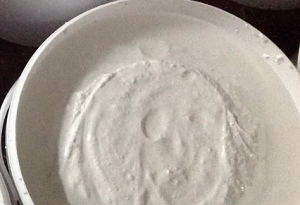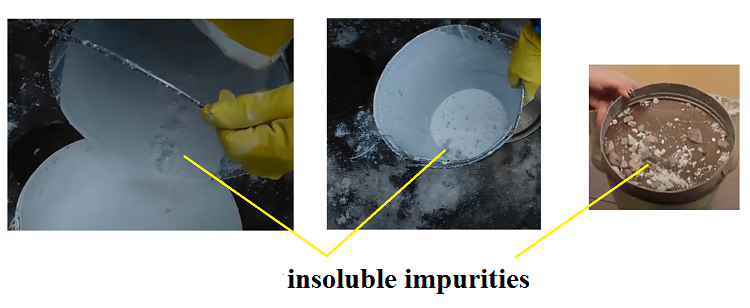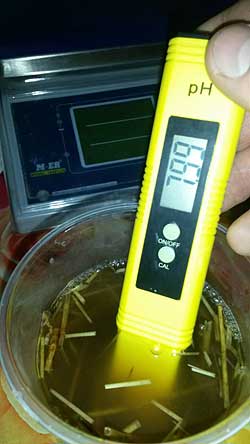The content of the article
Soda ash - commercially manufactured anhydrous sodium carbonate.
How much to add these components depends on:
The main goal is to bring the pH level of the substrate to 7.8-8.5. This pH is only necessary for oyster mushroom substrates! For other types of mushrooms (for example, shiitake, button mushroom, lion's mane, the pH needs to be different for each type)
Speaking in a completely scientific way, pH level does not show the alkalinity or acidity of the substrate (or water) separately, but the acid-base balance.
If it is 7, the solution is said to be neutral.
If more than seven, then it is alkaline.
In some regions, the water has an alkaline reaction (above 7), and the substrate overgrows without stains and mold. If the mushroom grower uses fresh, clean husks, lime can be omitted.
Alkalize the water for the oyster mushroom substrate if tap or well water has an acidic reaction - from 6.5 and below.
Pasteurization is the process of heating raw materials with steam in order to destroy swollen mold and bacteria spores.
Therefore, the process of disinfecting raw materials with lime solution cannot be called “pasteurization” or "lime pasteurization".
However, this method can be called chemical sterilization of mushroom substrate. Especially if a weak solution of sodium hypochlorite is added to the lime mortar. Sodium hypochlorite must be handled very carefully, so I never recommend its use and I am not giving specific numbers here.
There is also a way to sterilize raw materials with hydrogen peroxide. I've read about it, but never done it myself. And I don't recommend it to you. Because if your raw materials are dusty or dirty, peroxide will not kill enough spores. And if your raw materials are clean, such as pellets of straw, hay and/or sawdust, then lime mortar is much safer and cheaper.
Disinfection of raw materials with lime is a method for producing a very small amount of substrate. For mushroom farms that grow oyster mushrooms for sale, I do not recommend it.
If you have clean, dry raw materials in which there are few spores and the mycelium is overgrowning without wet spots and without mold, you can use this method.
However, if the substrate becomes poorly overgrown and deteriorates, you will have to look for another way to disinfect the raw materials.
Typically, a 1% lime solution is used for this method. But, since pH depends on the quality of both the raw material and the lime itself, you may have to add more lime than 1%.
You should be guided by the fact that your solution should have a pH of about 10. And your substrate after soaking in the solution should have a pH of 8.5-9, but no more!
Read below how to prepare a lime solution. The raw materials are soaked for 15 to 24 hours. And this also depends on the properties of the raw material - how quickly it absorbs water, the degree of its grinding and some other factors.
For the qualitative growth of oyster mushroom mycelium without spots, certain values of the alkalinity of the plant mass are needed.
After heat treatment, it should be in the range of 7.5 (preferably 7.8) - 8.5 (8.2).
It is with this value that the oyster mushroom mycelium develops well. And the straw or husk is gradually acidified by the waste products of the mycelium.
Mold grows well in more acidic environments, so the pH we need will inhibit its growth.
High alkalinity (ph above 9) can damage the oyster mushroom mycelium.
Oyster mushroom mycelium develops slowly in such an alkaline environment; when it is oppressed, colonies of bacteria will grow. As a result, we get yellow spots not overgrown with mycelium.
More about mushroom block overgrowth problems
There is no need to add calcium carbonate (chalk) to the oyster mushroom substrate. It does not regulate pH and humidity in the substrate.

You must determine empirically: first give the water for analysis, in some regions it is alkaline enough to not add lime at all during hydrothermia.
But, if you still have to work with lime in hydrothermy, it is preferable to add lime paste to dry husks when filling bags.
When pasteurizing the substrate in the tunnel, a solution of lime or soda ash is poured in equal portions when soaking straw or sunflower husks.
At xerothermy (steaming dry raw materials with steam), lime must be mixed into water, which is used to cool the plant mass.
You can start adding 200 grams of quicklime per 100 kg of soaked raw material or (approximately) 35-40 kg of dry raw material. And be sure to control the pH. If it is lower than necessary, add the amount of lime, for example, take 300 grams.
Quicklime (such as in the photo at the top of the article) must be of good quality so that after diluting it in water, all the pebbles will dissolve. Such lime is called fatty (at least, that's what it is called in my country) - it does not contain insoluble impurities.

In addition, lime must necessarily be calcium, and not magnesian or dolomite. The last two have a large amount of magnesium oxide, MgO, and we do not need this at all.
It will not work to increase the alkalinity with ash. You can verify this empirically - by soaking ash with husks in water, and then measuring the pH.
 This device is called a pH meter.
This device is called a pH meter.
It is necessary to make an extract.
Here is a short guide.
Take a glass jar, pour 250 ml of water into it and make a mark at this level.
Here in such a jar with a label, you can now measure the pH correctly.
Take a sample of 25 gr. and fill up to the mark with distilled water.
Stir, leave for 30-40 minutes. Then define.
It is desirable to grind a straw substrate sample with scissors up to 1-2 cm. But, as far as I know, no one grinds it.
When pasteurizing in a tunnel, pH is measured twice - before laying in the tunnel and during sowing, three or four samples (depending on the length of the tunnel) from different places in the tunnel.
This method is, of course, very approximate.
A strip of litmus is pressed with a finger to the steamed mass on the inoculation table and the result will be seen. But there will be no tenths, and sometimes it is important.
Of course, if a litmus paper shows a pH of less than 7, you will understand that you need to add lime, but it will be difficult to “guess” how much to add without an accurate device.
